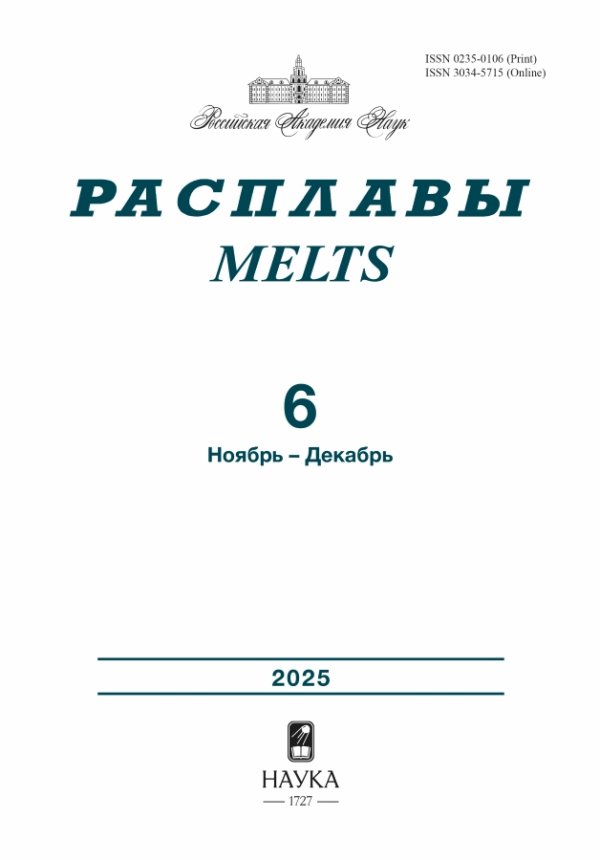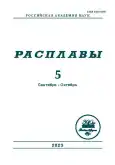Математическая модель кристаллизации катодного осадка UO2–ZrO2 при одновременном протекании на электроде электрохимической и химической реакций
- Авторы: Кротов В.Е.1, Филатов Е.С.1
-
Учреждения:
- Институт высокотемпературной электрохимии УрО РАН
- Выпуск: № 5 (2023)
- Страницы: 467-478
- Раздел: Статьи
- URL: https://journals.rcsi.science/0235-0106/article/view/141793
- DOI: https://doi.org/10.31857/S0235010623050067
- EDN: https://elibrary.ru/ZQZOKN
- ID: 141793
Цитировать
Полный текст
Аннотация
Представлена математическая модель электролитического синтеза кристаллического катодного осадка UO2–ZrO2 при одновременном и непрерывном протекании на электроде электрохимической и химической реакций. Диоксид урана образуется по электрохимической реакции восстановления ионов уранила \({\text{UO}}_{2}^{{2 + }}{\text{,}}\) цирконий попадает в осадок по химической реакции обмена. При использовании уравнений Фарадея и Фика получено выражение для расчета содержания диоксида циркония в системе UO2–ZrO2. Оно адекватно описывает процесс синтеза в расплаве NaCl–KCl–UO2Cl2–ZrCl4. Установлено качественное совпадение геометрической формы зависимостей, и, в ряде случаев, количественное соответствие расчетных и экспериментальных значений концентрации диоксида циркония от условий процесса (концентрации ZrCl4, плотности тока, длительности электролиза и температуры). Расхождение величин объяснено улетучиванием части ZrCl4 из электролита при электролизе, что не учитывалось при выводе аналитического уравнения.
Об авторах
В. Е. Кротов
Институт высокотемпературной электрохимии УрО РАН
Автор, ответственный за переписку.
Email: vekro@ihte.uran.ru
Россия, Екатеринбург
Е. С. Филатов
Институт высокотемпературной электрохимии УрО РАН
Email: vekro@ihte.uran.ru
Россия, Екатеринбург
Список литературы
- Кротов В.Е. Влияние состава расплава NaCl–KCl–UO2Cl2–ZrCl4–UCl4 на среднее содержание диоксидов урана и циркония в катодном осадке UO2–ZrO2 // Расплавы. 2011. № 2. С. 40–48.
- Krotov V.Ye. Regularities of cathode deposit formation during simultaneous reduction and exchange reactions. The mechanism of UO2–ZrO2 cathode deposit formation // Electrochim. Acta. 2014. 115. P. 28–30.
- Krotov V.Ye., Filatov Ye.S. Regularities of cathode deposit formation during simultaneous reduction and exchange reactions. Influence of the electrolysis conditions on the concentration of components in the UO2–ZrO2 cathode deposit // Electrochim. Acta. 2014. 116. P. 484–489.
- Krotov V., Filatov Ye. Anomalous influence of electrochemically inert ZrCl4 on UO2 current efficiency during electrolysis in (NaCl–KCl)equim–UO2Cl2–ZrCl4 melt // Electrochim. Acta. 2014. 145C. P. 254–258.
- Krotov V.Ye., Filatov Ye.S. Electrolytic Formation of Solid Crystalline UO2–ThO2 and UO2–ThO2–ZrO2 solutions from salt melts // Electrochem. Society. 2020. 167. P. 162507.
- Самойлов А.Г., Каштанов А.И., Волков И.С. Дисперсионные тепловыделяющие элементы ядерных реакторов. М.: Атомиздат, 1965.
- Смирнов М.В. Электродные потенциалы в расплавленных хлоридах. М.: Наука, 1973.
- Комаров В.Е., Хохлова А.М. Плотность расплавов хлоридов щелочных металлов с уранилхлоридом // Физическая химия и электрохимия редких металлов в солевых расплавах. 1984. С. 40–44.
- Барабошкин А.Н., Виноградов-Жабров О.Н. Хронопотенциометрия с реверсированием тока. Переключение из стационарного состояния // Тр. Института электрохимии УФАН СССР. 1970. № 15. С. 118–125.
- Бердников И.А. и др. Потенциостатический и импульсно потенциостатический электролиз системы KCl–NaCl–K2ZrF6. Свердловск. УПИ им. С.М. Кирова. 1977.
- Поляков П.В., Исаева Л.А., Анохина В.С. Исследование диффузионного слоя методом голографической интерферометрии в расплавленных солях // Изв. Вузов. Цветная металлургия. 1976. № 5. С. 60–65.
- Исаева Л.А., Поляков П.В., Михалев Ю.Г., Овчинников А.В. Температурная зависимость толщины диффузионного пограничного слоя при электролизе расплавленных солей // Электрохимия. 1980. № 16. С. 1705–1709.
- Исаева Л.А., Поляков П.В., Михалев Ю.Г., Рогозин Ю.Н. Диффузионный слой у жидкого и твердого металлических электродов в расплавленных солях // Электрохимия. 1982. 18. № 12. С. 1697–1699.
- Барабошкин А.Н., Смирнов М.В., Салтыкова Н.А. Измерение коэффициентов диффузии ионов серебра и циркония в расплаве хронопотенциометрическим методом // Тр. Института электрохимии УФАН СССР. Свердловск. 1970. № 15. С. 118–125.
- Chalkley I.R. The pilot plant production of electrolytic uranium dioxide // J. Less-Common Metals. 1961. 3. P. 98–109.
- Schlechter M., Kool J., Billian R., Charlier R.A., Dumont G.L. The preparation of UO2 by fused salt electrolyses using or UF4 as starting material // J. Nucl. Mater. 1965. 15. P. 189–200.
- Eichler B. Herstellung von grobkristallinem UO2 hoher Dichte durch elektrochemische Reduktion von UO2Cl2 in KCl–NaCl – Schmelze // Kernenergie. 1971. 14. P. 253–256.
- Справочник химика. Том II. Химия, Ленинградское отделение, 1971.
- Lister R.S., Flengas S.N. On the relationship between eequilibrium pressures and the phase diagram of a reactive system the systems: NaCl–Na2ZrCl6, KCI–K2ZrC6, NaCl–KC1–ZrC14 // Canadian journal of chemistry. 1965. 43. P. 2947–2969.
- Кротов В.Е., Филатов Е.С. Изменение количественного состава расплава NaCl–KCl–UO2Cl2–ZrCl4 при его электролизе // Расплавы. 2016. № 6. С. 489–499.
- Krotov V.E., Filatov Ye.S. Change in the quantitative composition of the NaCl–KCl–UO2Cl2–ZrCl4 melt during its electrolysis // Russian Metallurgy. 2018. № 2. P. 214–219.
Дополнительные файлы















